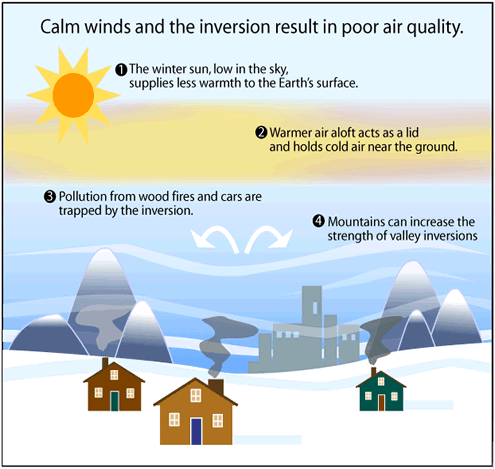Learn
![]()
Air pollution occurs when harmful substances—such as chemicals, particulate matter, or organic matter—are emitted into the atmosphere. These substances may cause harm to humans, animals, the natural environment, and the man-made environment.
Compounds that cause air pollution can be emitted into the atmosphere by both natural and human means. Air pollution caused by human actions is referred to as anthropogenic air pollution. Air pollution cause by natural events is often referred to as non-anthropogenic air pollution. Non-anthropogenic air pollution is caused by events such as wildfires, volcanic activity, and dust/sand storms. These types of natural events can release greenhouse gases (wildfires and volcanoes), compounds that cause acid rain (volcanoes), and particulate matter (all three) into the atmosphere that can reduce air quality. Natural causes of air pollution are not as serious of a problem as human-caused air pollution.

This diagram shows how anthropogenic and non-anthropogenic air pollution enters the atmosphere and affects its composition. Click the image for a larger version.
![]()
Humans rely on energy in all aspects of their daily lives. The majority of this energy comes either directly or indirectly from the combustion of fossil fuels. As you learned in Unit 4, when burned, fossil fuels release harmful byproducts into the atmosphere. These byproducts cause global warming, acid rain, ozone, and hazy conditions.
Natural events like thermal inversions can increase the effects of these air pollutants on humans and the environment. Thermal inversions can occur because of weather fronts moving into a region or from terrain features such as mountains pushing cooler air down into the valleys. A thermal inversion is when a layer cooler air is trapped under a layer of warmer air. Usuially in the troposphere, air temperature decreases with altitude. With thermal inversions temperature increases with altitude. This type of air is stable which keeps the pollutants from being distributed causing them to become more concentrated at the earth's surface. This increases the effects of smog and ozone.

Humans are also responsible for air pollutants such as ozone-depleting substances and volatile organic compounds.
Read the following article of air pollution DES: Air Pollution. Login instructions
![]() Air pollutants can be classified as either primary pollutants or secondary pollutants. Primary pollutants are released directly into the atmosphere. Pollutants released into the atmosphere during the combustion of fossil fuels and the burning of organic matter are primary pollutants. Examples of primary pollutants are
Air pollutants can be classified as either primary pollutants or secondary pollutants. Primary pollutants are released directly into the atmosphere. Pollutants released into the atmosphere during the combustion of fossil fuels and the burning of organic matter are primary pollutants. Examples of primary pollutants are
- carbon dioxide,
- sulfur dioxide,
- nitrogen oxides,
- volatile organic compounds,
- carbon monoxide,
- particulate matter, and
- ozone depleting chemicals.
Visit EPA: What Are the Six Common Air Pollutants? to see six common air pollutants. This is a review from Unit 4.
Secondary pollutants are not emitted directly into the air. They formed when primary pollutants react in the atmosphere, often in the presence of ultraviolent radiation, to form new compounds. Examples of secondary air pollutants are
- ozone,
- sulfuric acid, and
- nitric acid.
You should recall from the previous lesson that ozone in the troposphere is a pollutant that is the major component in smog. You should also remember from Unit 4 that sulfuric acid and nitric acids contribute to acid rain that can affect water quality for earth's surface waters.
![]()
Since the beginning of time, humans have been having both negative and positive impacts on the environment. Fossil fuels have also have provided many benefits for humans. Fossil fuels, and technologies that use fossil fuels, have had major economic impacts on countries by increasing the standard of living through technological advancements—such as automobiles, planes, trains, and farming equipment. These factors have made humans more mobile, allowed them to transport resources over great distances, and improved agricultural/food production. However, these same things have also led to negative impacts on the environment, such as air pollution that is a result of burning these fossil fuels.
Social, political, environmental, and economical impacts that fossil fuels have often lead to controversy when it comes to solving problems with air pollution. In 1970, Congress passed the Clean Air Act to help reduce air pollution. This act has been amended over the years. The Environmental Protection Agency is responsible for making sure that the guidelines of the Clean Air Act are implemented and followed. This often creates problems between economic, social, and environmental concerns. When making decisions about situations that impact the environment, all factors — economics, environmental, and social — have to be considered.
For now there has to be a "give and take" mindset about the use of material that pollute the environment. To keep our standard of living, we have to use these materials in some amounts, but at the same time we have to be conscious of the environmental impacts and use/find alternative means to help reduce air pollution. Watch Changing with the Times: The Amendment of the Clean Air Act (2:12) to learn a little more about the Clean Air Act, the EPA, and how the Clean Air Act is a "working document" that often changes because of social, economic, and political reasons. Login information